Menus
- 30 years of ninja
- Kawasaki Ninja ZX-9R from 1994
- High-tech electronics lighter and smaller every year
- Kawasaki Days 2014
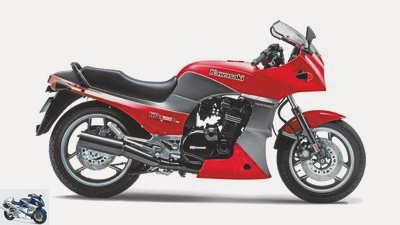
Manufacturer
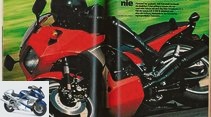
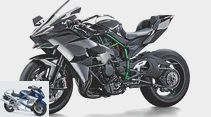
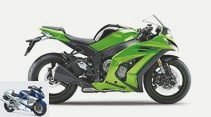

16 photos
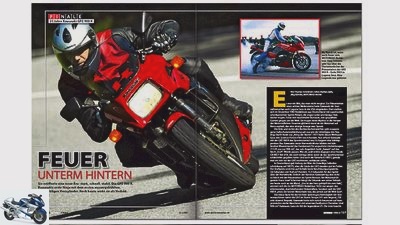
1/16
MOTORRAD celebrated 25 years of ninja in 2009 with an ode to the virtues of the 900s: sheer performance and stability.
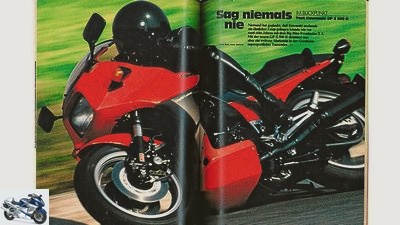
2/16
How it all began: Right from the first test of the GPZ 900 R in MOTORRAD,
Issue 5/1984 it was considered a “landmark”.
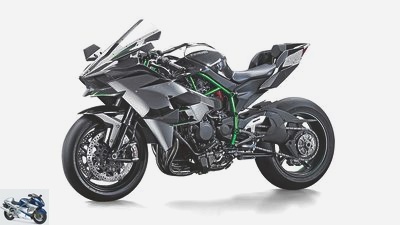
Kawasaki
3/16
2015: The H2 is supposed to bring the supremacy back to Kawasaki with a supercharger and 300 hp.
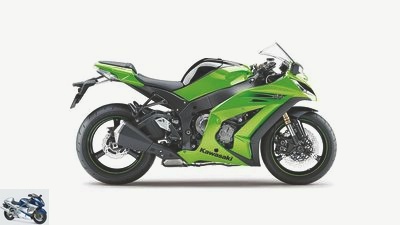
Kawasaki
4/16
2011: ZX-10R Now there were electronic helpers at Kawasaki too, without which customers and comparison tests cannot be won.

Kawasaki
5/16
2004: Ninja ZX-10R Light, almost 300 km / h fast and uncompromisingly sporty, the 10 series helped the Greens out of the crisis.
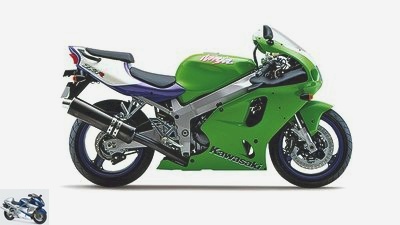
Kawasaki
6/16
1996: The Ninja ZX-7R replaced the successful ZXR 750, stronger and more stable, with an aerodynamically sophisticated fairing – but not necessarily faster.

Kawasaki
7/16
2000: ZX-12R Kawasaki’s answer to the Suzuki Hayabusa broke the 300 km / h sound barrier.
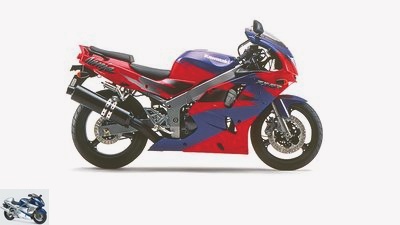
Kawasaki
8/16
1995: Ninja ZX-6R The small super sports car with the extremely short-stroke 600 was a complete success both in terms of sport and sales – and even suitable for everyday use.
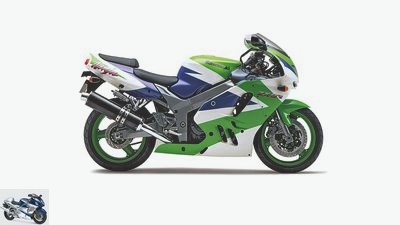
Kawasaki
9/16
1994: Ninja ZX-9R She sent the GPZ 900 to retire and introduced the new name with the addition of “Ninja” in Germany.
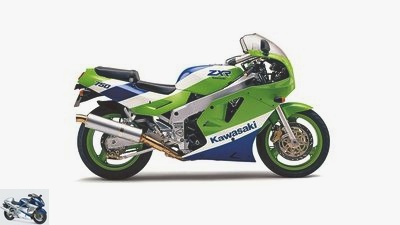
Kawasaki
10/16
… In the production version, however, they did not lead into the airbox.
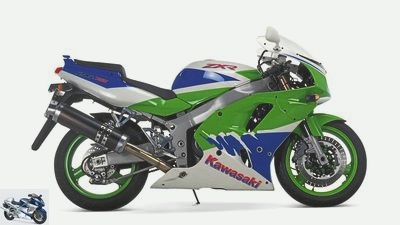
Kawasaki
11/16
1989: Ninja ZXR 750 The first with the famous vacuum cleaner hoses …
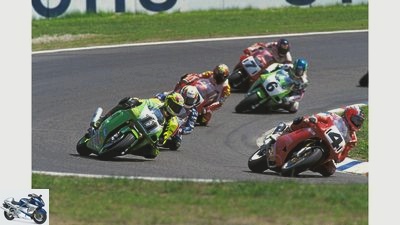
Kawasaki
12/16
1993: Ninja ZXR 750 L / M Although heavier than the previous year’s model, the versions built from 93 are the best and most successful ZXR 750. Scott Russell (left, # 11) won the Superbike World Championship with them in 1993; for Kawasaki the only title up to Tom Sykes ’World Championship victory last year.
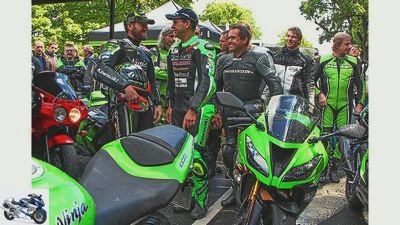
Streblow
13/16
Before the lap of honor: Tom Sykes, Horst Saiger and Jochen Schmid (from left) having a chat and with fans at the Oldtimer GP at the Schottenring 2014. Even rain showers couldn’t visibly spoil their mood.
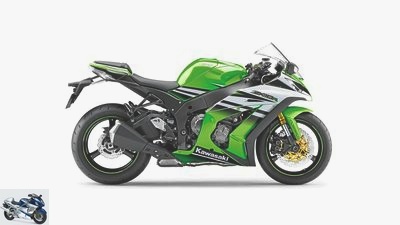
Kawasaki
14/16
2014: The ZX-10R Anniversary leaves 30 years in a direct comparison
Motorcycle development then become obvious. Shorter, squat, deep nose with a high tail, handlebar stumps at bench height, a frame like a monument.
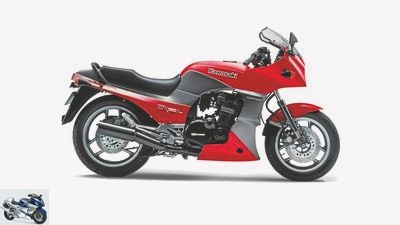
Kawasaki
15/16
1984: GPZ 900R The red one still doesn’t look like a classic car, although after 30 years it is clearly one of them.
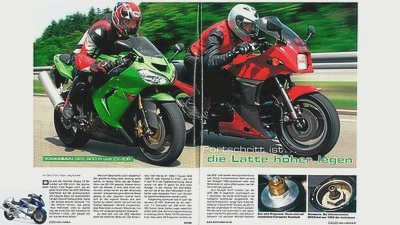
16/16
What is progress? Asked MOTORRAD in issue 20/2004
from 20 years of ninja development.
Kawasaki anniversary
30 years of ninja
Kawasaki’s super sports car with the complex name affix “Ninja” is turning 30. The jubilee was celebrated appropriately at the Kawasaki Days during the Oldtimer Grand Prix at the Schottenring.
As 1984 the first Kawasaki Ninja in the form of the GPZ 900 R came onto the market, it was only allowed to carry this name affix in the USA. During his time in Japan, the marketing director responsible for the American market, Mike Vaughan, was enthusiastic about the mythical underground fighters of the Middle Ages, who are considered fast and agile, but also, depending on your point of view, as ingenious as they are devious.
Buy complete article

Kawasaki anniversary
30 years of ninja
Round, stocky, crouched
A top speed of 248 kilometers per hour thanks to good aerodynamics and 115 hp from an extremely short-stroke and, for the first time, water-cooled four-cylinder were a statement in 1984 that made all competitors furrow their foreheads. A victory of the 900s in the Tourist Trophy on the Isle of Man in the same year established the reputation as a superior superbike. Soon afterwards, Kawasaki followed up with an optically almost identical 750 version, the first Kawasaki GPZ 600 R appeared more independent. Round, squat, crouched, that’s what super athletes looked like back then, the Suzuki GSX-R 750 had shown it in 1985.
And the greens? Countered in 1989 with the Kawasaki ZXR 750, which was already race-tested when it was released, which still followed that look for a model cycle, but was now able to score for the first time with the frame layout that should remain standard today: the aluminum bridge frame. Over 20 kilograms lighter than the GPZ models, the 750 with the abbreviation H1 was designed for use on the racetrack like never before. The first years of construction accordingly proudly walked their intake hoses, which ran out of the fairing through the tank and apparently into the airbox, including the ZXR 400, which was added in 1991. So there was still space next to these super athletes, and so the GPZ 900 R enriched the model range of the German Kawasaki importer for almost ten years up until the 1993 season became a milestone in motorcycle history.
Kawasaki Ninja ZX-9R from 1994
It only had to give way in 1994, from then on the Kawasaki Ninja ZX-9R played the role of the 900. At the same time, she introduced the naming that is still valid today. Ninja is now officially emblazoned on the German models. Where the name originally comes from is only of marginal interest, at least for the fans Ninja has become a supersport myth. The engine and chassis of the ZX-9R are offshoots of the superbike ZXR 750, the frame – now with beams – is more massive. Less weight with more power is the clear direction of those years, short model cycles are a sign of high development dynamics in the supersport sector, not only at Kawasaki.
The 600 class has been used by the Ninja ZX-6R since 1995, and a 750 series is also available again, the Ninja ZX-7R. In 1998, the lightest 900 ninja of all time, weighing 209 kilograms, and also the most powerful with 143 hp. Suzuki’s Hayabusa finally needs a clear answer, and it’s called the Kawasaki Ninja ZX-12R at the turn of the millennium. At 243 kilograms it is exactly as heavy as the first ZX-9R, but lifts 178 hp and breaks the 300 barrier.
MOTORCYCLE Market: Used Kawasaki ZX-6R 636 Ninja
High-tech electronics lighter and smaller every year
In 2004, twenty years after the appearance of the GPZ 900 R, the displacement size 900 said goodbye, the full liter is now available in the Kawasaki Ninja ZX-10R. 50 kilograms lighter than the 12 series, with 175 hp it still offers almost the same output. In the last ten years, the developers found another 25 hp in the ZX-10R, but could not prevent the 10er from building up a bit of fat again. What can be justified with the mandatory conversion to Euro 3, which made every sports motorcycle around ten kilograms heavier and presented the manufacturers with new challenges.
Since 2011, the electronic driving and braking aids, which are particularly popular in German-speaking countries, have also been found in the Kawasakis, which made the motorcycle about two to three kilograms heavier. In return, driving became safer. Nobody needs to worry, Kawasaki is still working hard on reducing weight, despite emissions regulations and electronic developments. In addition, high-tech electronics are getting lighter and smaller every year. Every rider can then feel a bit like Tom Sykes, the likeable Superbike World Champion from 2013. He enriched the Kawasaki Days 2014, gave autographs, smiled into the cameras and rolled at a leisurely pace on a lap of honor around the street circuit in Schotten – on a completely standard Kawasaki Ninja ZX-10R, of course from the current 30-year anniversary edition.
The ninja myth continues. The performance of the supercharged 1000 Ninja H2 presented at the autumn trade fairs in 2014 is beyond imagination and is intended to bring back the Blue Ribbon of the fastest sports motorcycle to Kawasaki. It’s nice that the name Ninja can not only adorn the absolute high-flyers, but also small 250 and 300 Kawas. Maybe even a 125cc soon?
Kawasaki Days 2014
It was only the second time that Kawasaki Germany held its brand meeting called Kawasaki Days, and it was at one of the most renowned classical music events in Germany. At the Oldtimer Grand Prix at the Schottenring 12,000-15,000 visitors are expected, now, according to the organizers, there were 19,000 weatherproof fans who braved the heavy rain showers for both events. In addition to Tom Sykes, the German Superbike champion from 1995, Jochen Schmid, Isle of Man participant Horst Saiger and old star Toni Mang romped around the tent and at the Kawasaki stands, gave autographs and made small talk with the visitors. A lap of honor by the stars on (a few) old and new ninjas, test drive laps and booths of the house tuners completed the program.
Related articles
-
Report: 25 years of Kawasaki Ninja
archive 16 photos Kawasaki 1/16 1984: Kawasaki GPz900R Ninja The evolution of the Kawaski from 25 years ago to the present day. Kawasaki 2/16 2003:…
-
Kawasaki Ninja ZX-10R in the PS driving report
Kawasaki 34 pictures Kawasaki 1/34 Kawasaki ZX-10R (2016). Kawasaki 2/34 Kawasaki ZX-10R (2016). Kawasaki 3/34 Kawasaki ZX-10R (2016). Kawasaki 4/34 …
-
Kawasaki Ninja H2R in the PS driving report
Kawasaki 31 pictures Kawasaki 1/31 310 PS is an announcement. But how does it feel? Kawasaki 2/31 The new Kayaba fork is fully adjustable. Kawasaki …
-
Kawasaki ZXR 400 Kawasaki Ninja 400 comparison test
fact 14 pictures fact 1/14 Basically, the ZXR 400 owes its origin to the TT on the Isle of Man. fact 2/14 Kawasaki ZXR 400. fact 3/14 Because the TT-F3 …
-
Driving report Kawasaki Ninja 400 (2018)
Arturo Rivas 29 photos Arturo Rivas 1/29 Kawasaki has redesigned the entry-level ninja. The twin’s cubic capacity and power increased, which is now…
-
Honda CBR 250 R and Kawasaki Ninja 250 R super athletes in the test
Gargolov comparison test: Honda CBR 250 R and Kawasaki Ninja 250 R Small super sports cars in the test Is there a market in Germany for …
-
Kawasaki Ninja H2 in the top test
Bilski 26 pictures Bilski 1/26 Mi 218 hp, the H2 is the most powerful bike on the MOTORRAD test bench to date. Bilski 2/26 The polished stainless steel elbows form …
-
Kawasaki Ninja ZX-10R – old versus new compared
fact 24 pictures www.factstudio.de 1/24 Kawasaki ZX-10R: old versus new. www.factstudio.de 2/24 Kawasaki ZX-10R 2016: Brembo instead of Tokico, “balance free” …
-
Kawasaki Ninja 300, KTM RC 390, Honda CBR 300 R and Yamaha YZF-R3 in the test
markus-jahn.com 42 pictures markus-jahn.com 1/42 Four bikes compete to compare the third-liter athletes. markus-jahn.com 2/42 The Honda fork …
-
Differences between Kawasaki Ninja H2 and Kawasaki Ninja H2R
Kawasaki 22 pictures Kawasaki 1/22 The Kawasaki Ninja H2 has no R in its name and over 100 hp less. What does it offer instead? Kawasaki 2/22 Kawasaki …